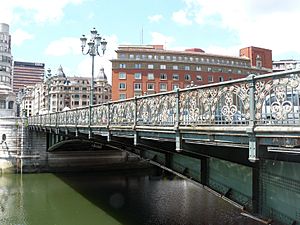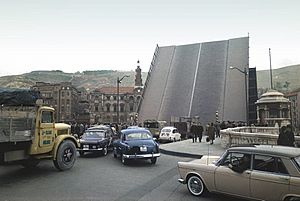City Hall Bridge facts for kids
Quick facts for kids City Hall BridgeUdaletxeko zubia |
|
|---|---|
 |
|
| Coordinates | 43°15′36″N 2°55′12″W / 43.26000°N 2.92000°W |
| Locale | Bilbao, Spain |
| History | |
| Opened | 12 December 1934 |
The City Hall Bridge (called Udaletxeko zubia in Basque and Puente del Ayuntamiento in Spanish) is a unique bridge in Bilbao, Spain. It's a type of bridge called a bascule bridge, which means it can open up to let ships pass through. This bridge connects the areas of Abando and Gazteleku across the estuary of Bilbao.
Contents
Why Was the City Hall Bridge Built?
In the late 1920s, the city of Bilbao was growing fast. It needed a new way to connect its main center with the Bilbao City Hall and the nearby Begoña area. So, the idea for a new bridge was born.
The city decided to build a special bridge that could open. This was important because large commercial ships needed to travel up and down the estuary to the port. An opening bridge would allow these ships to pass without any problems.
Designing the Bridge
In 1926, the mayor of Bilbao, Federico Moyúa, sent an architect named Ricardo Bastida to Chicago, USA. Bastida's mission was to study different types of opening bridges. At that time, bridges that used a "cantilever" design (like a diving board) were very popular.
In Chicago, Bastida was especially inspired by the Michigan Avenue Bridge, which had been built a few years earlier in 1920. When he returned to Bilbao, Bastida worked with engineers Ignacio Rotaetxe and José Ortiz de Artiñano to design the new bridge.
The design for the bridge was finished in 1929. Its construction began in October 1933. Two important factories, Euskalduna and Babcock & Wilcox, helped build the bridge.
A Bridge Through Time
The bridge first opened on December 12, 1934. It was originally known as the Begoña Bridge. However, its story took a difficult turn during a conflict in Spain. On June 17, 1937, the bridge was unfortunately destroyed.
After the conflict, a temporary bridge was put in place using barges. Soon, work began to rebuild the permanent bridge. It was reopened in 1941 and was given a new name, "General Mola's Bridge."
Many years later, in 1983, the bridge got its original name back: the City Hall Bridge.
Checking the Bridge's Health
Bridges need to be checked regularly to make sure they are safe and strong. In 2021, the Bilbao City Council performed a detailed check on the City Hall Bridge. This inspection confirmed that the bridge was still in good condition and structurally sound.
See also
 In Spanish: Puente del Ayuntamiento para niños
In Spanish: Puente del Ayuntamiento para niños


